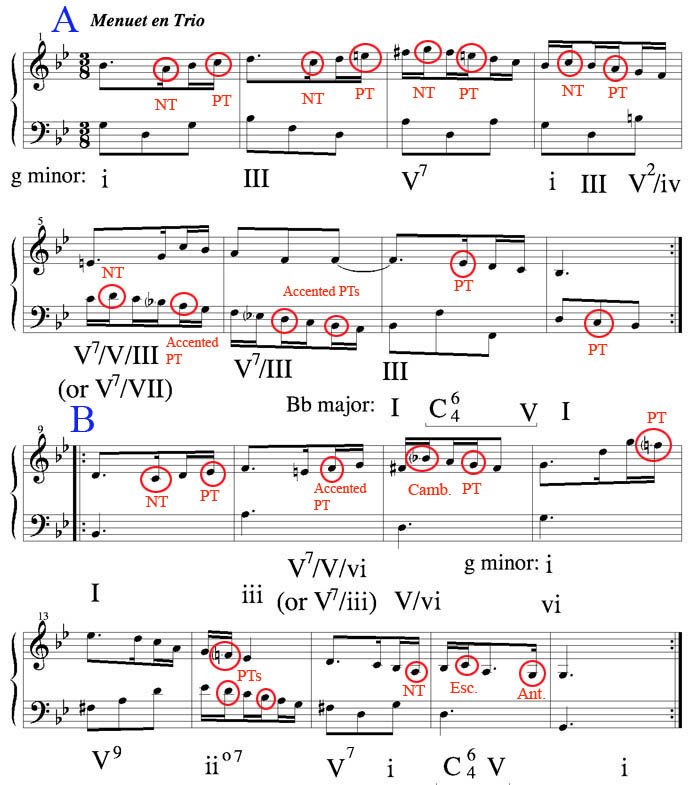
Dr. Justin Henry Rubin © 2006
The emergence of instrumental music as an independent genre from its earlier function as primarily a support for (or elaboration of) vocal music takes a large step forward at the dawn of the seventeenth century. Specifically, dances, which were invariably heretofore the most significant forms for which purely instrumental music was suited, continued to be one of the sources of inspiration for Baroque composers regarding their conception of structure. Many of these dances, such as the Allemande, Courante, Sarabande, Minuet, Gigue, etc., were cast in binary forms. Eventually this structure itself became independent of the dances that they were originally associated with and composers have continued to use binary forms in subsequent eras to give cohesion to vastly different musical materials.
In essence, binary form consists of two repeated sections, A and B, which have close musical ties in regards to motifs and textures. In many cases, when in a major key, the A section will cadence in the dominant while the B section will begin in the dominant and return to the tonic by its conclusion. Similarly, when in a minor key, the A section often will cadence in the relative major while the B section will begin in the relative major and return to the minor key tonic by its conclusion. While there are many binary form pieces in the literature in which each section was of equal, or near equal length (as with the dance movements), this is not a prerequisite as there are also numerous examples in which the B section greatly outweighs the A. In such cases, the B section can begin to take on a developmental character, and can be considedered a precursor to the sonata.
For our study of binary form, we will begin with two completed examples, a minuet and allemande. This will enable us to grasp the harmonic functionality and overall structure before composing one step by step.
Index
A. Minuet
B. Allemande
C. Step-by-Step Example
AUDIO and MIDI files can be listened to on this page or downloaded separately here.
In the following example, we will create a French-styled Minuet (called a Menuet) in three voices in a minor key.
1. Although in a three part composition such as this it is not absolutely necessary to begin with only two voices, the student is encouraged to keep the texture less complicated at the outset. One good practice in composing binary forms is to set up your score so that you are drafting both the A and B sections simultaneously, allowing each phrase to draw on material from the other to ensure musical unity. Notice, for instance, the melodic material in bars 1-2 is identical to that in bars 9-10, save for their starting pitches. In bars 1-2, we are establishing the g minor tonality, while in 9-10 a Bb (relative major) tonal center must be adhered to. Notice too that the rhythmic activity is transferred to the bass in bars 5-6 as well as 14 to allow for variety in the texture.
Of particular importance are the two modulations that occur in bars 6-7 and 11-12 to the appropriate key regions. Note that these transitions can occur at varying places within the sections. For instance, here the first modulation occurs mid-way in A but very early in B. To reinforce these modulations, tertiary dominants (or the dominant of the dominant of the new key) are employed in bars 5 and 10. These are immediately resolved correctly to secondary dominants that lead to the new tonal centers.
Note: Most chord indications here do not specify inversions - this is not as relevant to the course of instruction here where harmonic regions in which the materials are functioning is of primary importance.

2. Next, a third voice is added in between the two parts already composed. The student shouldn't feel obligated to preserve the original lines without any changes - more often than not, with the introduction of another voice, new ideas will inspire the composer. However, the harmonic implications that have already been established should be maintained to a strong degree. Note too that this third voice here acts mostly in a supporting role, filling out harmonic implications and tying together the textures of the other voices; it never becomes a strong melodic component.
mp3 download (ensemble arrangement for violin, clarinet, harp, and violoncello)
score download (of ensemble arrangement)
Go on to the next binary form examples.
The views and opinions expressed in this page are strictly those of the page author.
The contents of this page have not been reviewed or approved by the University of Minnesota.
View Privacy Statement
Copyright © 2005 by Justin Henry Rubin
http:// www.d.umn.edu /~jrubin1
The University of Minnesota is an equal opportunity educator and employer. ![]()